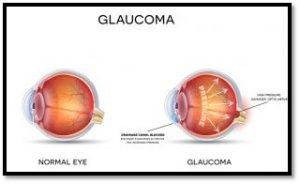Glaucoma is a group of eye conditions that damage the optic nerve. The optic nerve sends visual information from your eye to your brain and is vital for good vision. Damage to the optic nerve is often related to high pressure in your eye. But glaucoma can happen even with normal eye pressure.
Glaucoma can occur at any age but is more common in older adults. It is one of the leading causes of blindness for people over the age of 60.
Many forms of glaucoma have no warning signs. The effect is so gradual that you may not notice a change in vision until the condition is in its later stages.
It’s important to have regular eye exams that include measurements of your eye pressure. If glaucoma is recognized early, vision loss can be slowed or prevented. If you have glaucoma, you’ll need treatment or monitoring for the rest of your life.
There’s five factors that help your primary eye care provider determine if you have glaucoma:

- Tonometry – to check the inner eye pressure.
- Ophthalmoscopy(dilated eye exam or retinal screening) – to check the shape and color of the optic nerve head.
- Perimetry(visual field) – to check the complete field of vision.
- Gonioscopy– to check the angle inside the eye where the iris meets the cornea.
- Pachymetry– to check the thickness of the cornea.
Symptoms:
- Most glaucomas do not have symptoms in their early stages.
- Some patients might experience patchy blind spots on peripheral vision.
- Blurriness in central vision in later stages.
Acute angle-closure glaucoma Symptoms:
- Severe headache
- Severe eye pain
- Nausea or vomiting
- Blurred vision
- Halos or colored rings around lights
- Eye redness
If you experience the symptoms from Angle-Closure glaucoma, you need treatment. Go to an emergency room or call an ophthalmologist office immediately.

